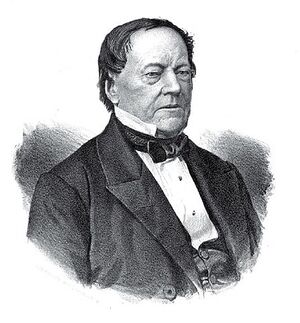Per Georg Scheutz (nonfiction): Difference between revisions
(Created page with "'''Pehr (Per) Georg Scheutz''' (23 September 1785 – 22 May 1873) was a 19th-century Swedish lawyer, translator, and inventor, who is now best known for his pioneering work i...") |
No edit summary |
||
| Line 1: | Line 1: | ||
'''Pehr (Per) Georg Scheutz''' (23 September 1785 – 22 May 1873) was a 19th-century Swedish lawyer, translator, and inventor, who is now best known for his pioneering work in computer technology. | [[File:Georg_Scheutz.jpg|thumb|Per Georg Scheutz.]]'''Pehr (Per) Georg Scheutz''' (23 September 1785 – 22 May 1873) was a 19th-century Swedish lawyer, translator, and inventor, who is now best known for his pioneering work in computer technology. | ||
Scheutz studied law at Lund University, graduating in 1805. He then worked as a legal expert and translator (he translated several works of William Shakespeare and Sir Walter Scott) before turning predominantly to liberal politics and mechanical engineering. | Scheutz studied law at Lund University, graduating in 1805. He then worked as a legal expert and translator (he translated several works of William Shakespeare and Sir Walter Scott) before turning predominantly to liberal politics and mechanical engineering. | ||
He is most known for his inventions; the best known of these is the Scheutzian calculation engine, invented in 1837 and finalized in 1843. This machine, which he constructed with his son Edvard Scheutz, was based on Charles Babbage's difference engine. In 1851 they obtained funds from government to build an improved model, which was created in 1853 (was roughly the size of a piano), and subsequently demonstrated at the World's Fair in Paris, 1855. The machine was then sold in 1856 to the Dudley Observatory in Albany, New York. In 1857 British government ordered another model, which was built by Donkin's company in 1859. | He is most known for his inventions; the best known of these is the Scheutzian calculation engine, invented in 1837 and finalized in 1843. This machine, which he constructed with his son Edvard Scheutz, was based on [[Charles Babbage (nonfiction)|Charles Babbage]]'s difference engine. In 1851 they obtained funds from government to build an improved model, which was created in 1853 (was roughly the size of a piano), and subsequently demonstrated at the World's Fair in Paris, 1855. The machine was then sold in 1856 to the Dudley Observatory in Albany, New York. In 1857 British government ordered another model, which was built by Donkin's company in 1859. | ||
The devices were used for creating logarithmic tables. | The devices were used for creating logarithmic tables. | ||
While the machine was not perfect and could not produce complete tables, Martin Wiberg reworked the construction from the ground up and in 1875 created a compact device which would print complete tables. | While the machine was not perfect and could not produce complete tables, [[Martin Wiberg (nonfiction)|Martin Wiberg]] reworked the construction from the ground up and in 1875 created a compact device which would print complete tables. | ||
Scheutz was elected a member of the Royal Swedish Academy of Sciences in 1856. | Scheutz was elected a member of the Royal Swedish Academy of Sciences in 1856. | ||
== In the News == | |||
<gallery> | |||
</gallery> | |||
== Fiction cross-reference == | |||
* [[Gnomon algorithm]] | |||
* [[Gnomon Chronicles]] | |||
== Nonfiction cross-reference == | |||
* [[Charles Babbage (nonfiction)]] | |||
* [[Martin Wiberg (nonfiction)]] | |||
External links: | |||
* [https://en.wikipedia.org/wiki/Per_Georg_Scheutz Per Georg Scheutz] @ Wikipedia | |||
[[Category:Nonfiction (nonfiction)]] | |||
[[Category:Computation (nonfiction)]] | |||
[[Category:Inventors (nonfiction)]] | |||
[[Category:Lawyers (nonfiction)]] | |||
[[Category:People (nonfiction)]] | |||
[[Category:Translators (nonfiction)]] | |||
Latest revision as of 15:26, 23 September 2018
Pehr (Per) Georg Scheutz (23 September 1785 – 22 May 1873) was a 19th-century Swedish lawyer, translator, and inventor, who is now best known for his pioneering work in computer technology.
Scheutz studied law at Lund University, graduating in 1805. He then worked as a legal expert and translator (he translated several works of William Shakespeare and Sir Walter Scott) before turning predominantly to liberal politics and mechanical engineering.
He is most known for his inventions; the best known of these is the Scheutzian calculation engine, invented in 1837 and finalized in 1843. This machine, which he constructed with his son Edvard Scheutz, was based on Charles Babbage's difference engine. In 1851 they obtained funds from government to build an improved model, which was created in 1853 (was roughly the size of a piano), and subsequently demonstrated at the World's Fair in Paris, 1855. The machine was then sold in 1856 to the Dudley Observatory in Albany, New York. In 1857 British government ordered another model, which was built by Donkin's company in 1859.
The devices were used for creating logarithmic tables.
While the machine was not perfect and could not produce complete tables, Martin Wiberg reworked the construction from the ground up and in 1875 created a compact device which would print complete tables.
Scheutz was elected a member of the Royal Swedish Academy of Sciences in 1856.
In the News
Fiction cross-reference
Nonfiction cross-reference
External links:
- Per Georg Scheutz @ Wikipedia
